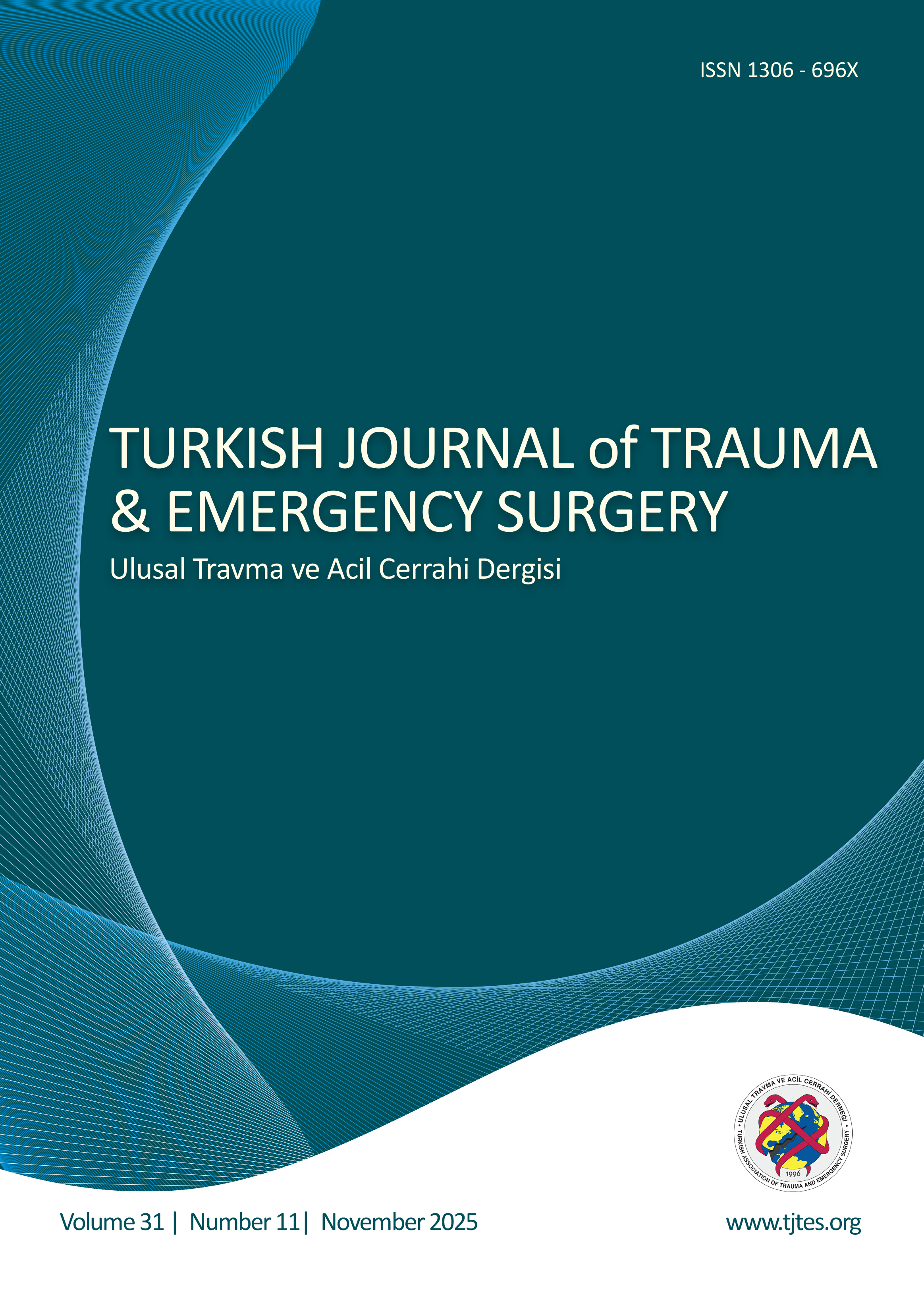Hızlı Arama
Travma merkezleri kurulmasının künt travmatik dalak yaralanması tedavisi üzerine etkisi: Travma merkezleri öncesi ve sonrası dönemlerin karşılaştırılması
Hyunseok Jang, Young-Goun Jo, Yunchul Park, Euisung Jeong, Naa Lee, Jung-Chul KimTravma ve Cerrahi Bölümü, Chonnam Ulusal Üniversitesi Tıp Fakültesi ve Hastanesi, Gwangju-Güney KoreAMAÇ: Dalak, künt travma nedeniyle yaygın olarak yaralanan bir batın içi organdır. Künt dalak yaralanması vakalarında sıklıkla acil tedavi gerekir. Bu çalışma, künt dalak yaralanması olan hastaların tedavisinde travma merkezleri kurulmasının prognostik etkisini araştırmayı amaçlamıştır.
GEREÇ VE YÖNTEM: 20122019 yılları arasında dalakta künt yaralanma nedeniyle merkezimizi ziyaret eden 235 hastayı geriye dönük olarak inceledik. Çalışma süresi iki gruba ayrıldı: Ocak 2012Eylül 2015 arası travma merkezi öncesi dönem (TÖD) ve Eylül 2015Aralık 2019 arası travma merkezi dönemi (TMD). Her bir dönemde, üç tedavi grubu mevcuttu: Cerrahi grup, embolizasyon grubu ve konservatif tedavi grubu. Birincil sonuç mortalite idi; ikincil sonuçlar ise, yaralanma şiddeti skoru (ISS) ve kısaltılmış yaralanma ölçeği puanı gibi hasta özellikleri, başvurudan müdahaleye kadar geçen süre (hem cerrahi hem de anjiyografi embolizasyonu) ve dalak koruyucu cerrahi oranı idi.
BULGULAR: Konservatif tedavi grubunda TMDde Hb ve Hct değerleri, TÖDye göre nispeten düşüktü (sırasıyla, p=0.007, p=0.008). TMDde yoğun bakıma yatış oranı nispeten yüksekti (%72.9a karşı %90.6, p=0.031). TMDde yaralanma şiddeti skoru (ISS) nispeten düşüktü (18e karşı 17, p=0.001). Cerrahi grubunda, hasta kabulünden sonra ameliyathaneye transfer için geçen süre TMPde büyük ölçüde azalmıştır (151 dakikaya karşı 107 dakika, p=0.028). Embolizasyon grubunda hastanın yaşı ve SBP, TÖDde TMDye göre daha düşüktü (sırasıyla p=0.003, p=0.049); TÖDde üç hastaya CPR ile embolizasyon uygulanmış, TMDde ise hiçbir hastaya CPR uygulanmamıştı. TÖDde üç ölüm mevcuttu; TMDde hiç ölüm gerçekleşmemişti (p=0.05).
TARTIŞMA: Bir travma merkezinin kurulması, künt dalak yaralanması olan ve üç tedaviden birini alan hastaların tedavi kalitesinde ve prognozunda iyileşmelere yol açmıştır.
Anahtar Kelimeler: Batın yaralanmaları, dalak, travma merkezleri.
Impact of the establishment of a trauma center on blunt traumatic spleen injury treatment: Comparison between pre-traumatic center and trauma center periods
Hyunseok Jang, Young-Goun Jo, Yunchul Park, Euisung Jeong, Naa Lee, Jung-Chul KimDivision of Trauma, Department of Surgery, Chonnam National University Medical School and Hospital, Gwangju-South KoreaBACKGROUND: The spleen is a commonly injured intra-abdominal organ from blunt trauma. In cases of traumatic blunt spleen injury, immediate treatment is often required. This study aimed to investigate the prognostic impact of the establishment of a trauma center on the treatment of patients with blunt trauma injury to the spleen.
METHODS: We retrospectively reviewed 235 patients who visited our center from 2012 to 2019 for blunt trauma injury to the spleen. The study period was divided into two groups: January 2012 to September 2015 was the pre-center period (PCP), and September 2015 to December 2019 was the trauma center period (TCP). In each period, there were three treatment groups: Surgical group, embolization group, and conservative treatment group. The primary outcome was mortality, and the secondary outcomes were patient characteristics, such as injury severity score and abbreviated injury scale score, time from admission to intervention (both surgery and angiography embolization), and rate of spleen-preserving surgery.
RESULTS: In the conservative treatment group, the Hb and hct values were relatively low in the TCP than in the PCP (p=0.007, p=0.008, respectively). The intensive care unit admission rate was relatively high in the TCP (72.9% vs. 90.6%, p=0.031). The ISS was relatively low in the TCP (18 vs. 17, p=0.001). In the surgical group, the time taken to transfer patients to the operating room after admission was greatly reduced in the TCP (151 min vs. 107 min, p=0.028). In the embolization group, the patients age and SBP were lower in the PCP than in the TCP (p=0.003, p=0.049, respectively); three patients had undergone embolization with CPR in the PCP, and no patient underwent CPR in the TCP. There were three deaths in PCP and none in the TCP (p=0.05).
CONCLUSION: The establishment of a trauma center has led to improvements in the treatment quality and prognosis of patients with blunt trauma injury to the spleen receiving either of the three treatments.
Keywords: Abdominal injuries, spleen, trauma centers.
Makale Dili: İngilizce





